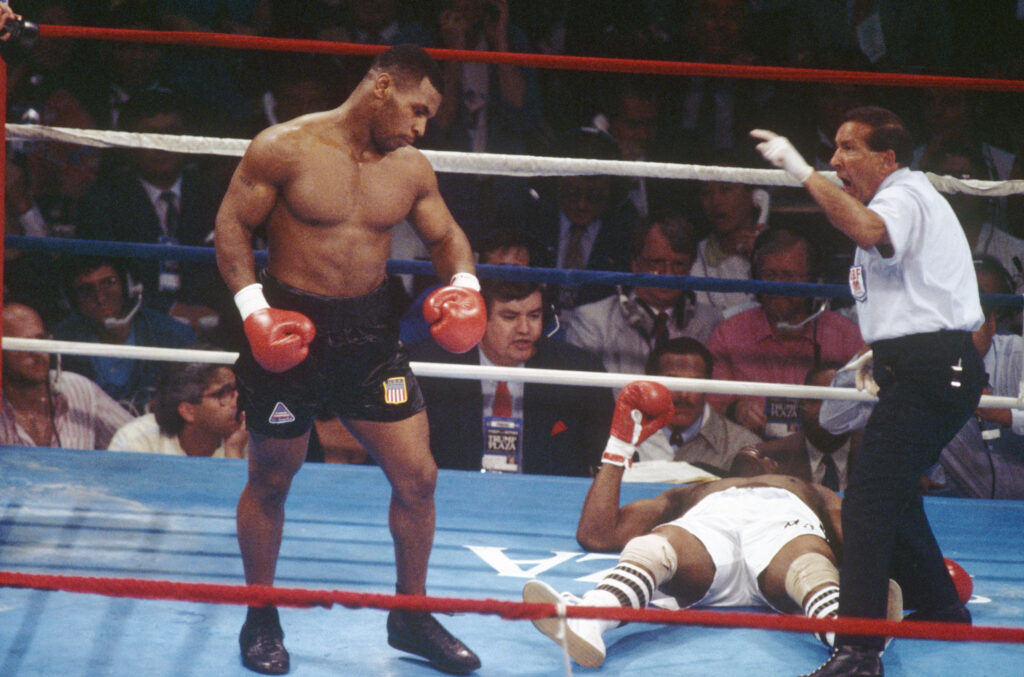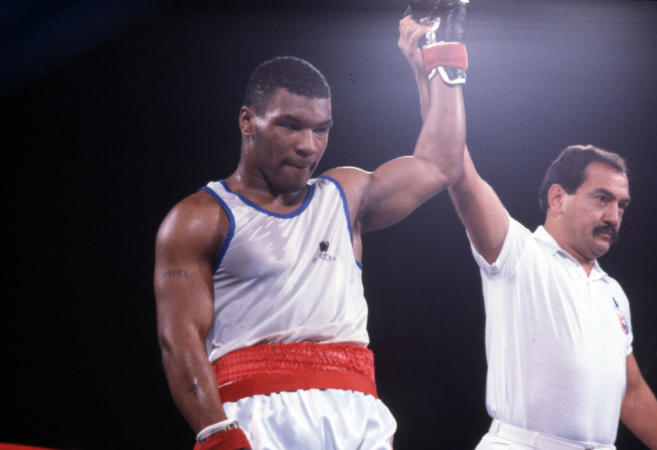If you’re a boxing fan, you’re likely still feeling a bit overwhelmed by the landmark Mike Tyson vs. Jake Paul match. The event, which was live-streamed on Netflix for hundreds of millions of excited viewers around the globe, brought with it a shocking fight purse payout of tens of millions of dollars for each fighter. This is before accounting for additional bonuses accrued by all parties from endorsement deals, advertising offers and speaking engagements. Needless to say, the exciting match-up has led many fans to wonder about the financial status of both Mike Tyson and his in-the-ring interlocutor. Tyson famously saw high financial highs and lows during his tenure as a professional boxer, including a shocking 2003 bankruptcy filing. Given that the question is on everyone’s mind, now seems like as good a time as any to investigate Tyson’s estimated net worth, various income streams and rise to prominence.
Early Life and Career Beginnings

Like many pro athletes, Mike Tyson’s childhood was mired with misfortune and adversity. The future legend was born in 1966 to an impoverished Brooklyn, New York family, and raised primarily by his mother, who is rumored to have served as a sex worker. As far as the public is aware, the identity of Tyson’s biological father is a mystery. The boxer’s birth certificate lists a Brooklyn cab driver by the name of Purcell Tyson as the father, though Mike grew up believing that a local pimp named Jimmy Kirkpatrick was his actual dad. Though Mike was aware of Kirkpatrick, the pimp abandoned the Tyson family shortly after he was born, leaving the matriarch to fend for herself. With no parental guidance in his life, Mike Tyson began running with the wrong crowd in his youth and frequently got into trouble with the law.
By the time he turned 13, the future champion had already racked up over 30 arrests and served multiple short-term bids in juvenile detention for a mix of street fights, petty crimes and other delinquent behaviors. During one of his stints in juvie, Tyson caught the eye of a youth councilor named Bobby Stewart, who previously served as a Golden Gloves boxing champion. Despite having taught himself to brawl in the mean streets of Bed–Stuy, Tyson had nearly flawless form, leading Stewart to refer the misguided youth to legendary trainer Cus D’Amato. Once released from his stay in juvenile detention, he began honing his skills with a coach by his side, which helped to keep him off the streets and focussed on his future. Before long, Mike was entering the ring with seasoned veterans, and even taking home gold medals in fights at the Junior Olympics.
Professional Boxing Career
The lion’s share of Mike Tyson’s massive net worth comes from his time in the professional boxing ring, where he rose from a scrappy street fighter to one of the greatest athletes the world has ever known. Shortly after turning 18, Tyson took to the professional stage with an impressive flurry of wins via TKO. In just one year as a professional boxer, he managed to knock out 26 consecutive opponents, 16 of whom went down during the first round. Given the East Coast icon’s ferocity and tenacity, it didn’t take long to earn fights against defending champions, including the likes of Marvis Frazier, whom Tyson bested in a match lasting just 30 seconds. In 1986, Iron Mike defeated Trevor Berbick in the ring to become the youngest heavyweight champion in boxing history.
From there, Tyson carried an undefeated record across a whopping 37 fights, before ultimately taking his first career loss in a 1990 match against Buster Douglas. This streak serves as one of the most impressive feats of athleticism ever shown in heavyweight boxing and serves to display why Iron Mike was such a feared legend in his heyday. Throughout his career in the ring, Tyson took home more than $685 million in salary alone. He even chose to forego any endorsement deals during his reign, as he felt the brand collaborations were unnecessary for fighters at his level.
Per a write-up in Afrotech, Mike Tyson explained, “I wasn’t interested in making my own sneaker. Some people wanted me to have my own sneaker, but I was moving too fast. I couldn’t take care of that stuff… I had my money, I didn’t need no deals.” Obviously, such deals were not necessary for Tyson’s success, as his pay-per-view ventures alone reached heights of over $40 million per fight.
Downfall and Controversies
Though Tyson grew to refer to his bout against Douglas as one of the greatest moments of his career, the shocking loss ultimately marked the beginning of the end for the esteemed fighter. Shortly after tarnishing his previously unimpeachable record, the then 25-year-old was arrested and convicted on sexual assault charges. Though Tyson continues to maintain his innocence in the controversial criminal suit to this day, he was ultimately sentenced to six years in prison, three of which he served before being released. Afterward, Tyson returned to the ring for several high-profile matches and even reclaimed his title as heavyweight champion of the world. Despite his renewed vigor, the industry icon’s outlook on boxing was never the same, and he failed to bring the same level of murderous passion to his fights.
This downward spiral was most evident in the landmark Mike Tyson vs Evander Holyfield II event in June of 1997. After losing to Holyfield a year earlier, Tyson was disqualified from the rematch towards the end of the third round. The disqualification came after the enraged boxer attempted, on multiple occasions, to bite Holyfield’s ears – a move that has since been parodied hundreds of times in modern pop culture circles. Tyson was fined over $3 million of his $30 million payout, and his license to fight in the state of Nevada was revoked for over a year. From there, he continued facing bad press, legal issues and personal controversies which left him completely drained and caused him to lose all passion for boxing. In 2005, Tyson quit in the middle of his final match, admitting he had no interest in continuing to fight.
Bankruptcy and Financial Troubles
As stated above, Mike Tyson’s multi-million dollar payouts did little to prevent him from financial ruin, leading him to file for bankruptcy in 2003. The revered boxer was noted for living a lavish lifestyle throughout his career, and a lack of formal education left him unable to properly budget. Even if he had an accounting background, Tyson likely would have been in financial trouble, as he was severely taken advantage of by the people in his orbit. The worst offender in this regard is boxing promoter Don King, who is said to have stolen as much as 50 percent of Tyson’s earnings throughout their decades-long business relationship. During the peak of Iron Mike’s fame, King listed himself, his wife, and each of his children in nebulous consultant roles to the boxer, siphoning hundreds of thousands of dollars each from the athlete’s fight earnings.
Beyond his relationship with parasitic industry insiders, Tyson was known to be extremely flagrant with his spending, and often purchased 6-figure gifts for his friends, family, and perfect strangers alike. Famously, the former heavyweight champ purchased a fleet of Bengal tigers, which were estimated to cost over $70,000 each. The tigers also required millions in maintenance and required home renovations, on top of Mike’s estimated $300,000 in annual landscaping bills. The father of four is rumored to have purchased over $4.5 million in vehicles in the late 1990s, most of which were given to friends as gifts. He also gave away various properties, paid for travel and lodging for a massive entourage and even paid a man over $300,000 just to stand behind him during press functions shouting the phrase “guerrilla warfare.”
Financial Comeback and Media Career
Luckily, Mike Tyson’s fighting spirit allowed him to turn his luck around, with some prolific media appearances, speaking engagements and marketing partnerships. During the late oughts into the mid-2010s, Tyson was known to host a wide array of public appearances on the Vegas Strip, some of which charged guests a whopping $37,500 per hour appearance fee. Here, Tyson met with fans, posed for photos and tapped into celebrity culture in a much healthier way than his past as an ear-biting, upper-cutting brawler would ever have allowed. Since then, Tyson has leaned into his media personality and appeared as a fictionalized version of himself in film and television ventures including Scary Movie V, How I Met Your Mother and the Hangover film franchise. Tyson also voiced a fictionalized version of himself in the hilarious cartoon series Mike Tyson Mysteries, which has since become a modern cult classic.
His autobiography, Mike Tyson: Undisputed Truth was turned into a one-man Broadway show with the help of producer Spike Lee, and eventually spawned an HBO adaptation. In 2022, Tyson made his international film debut with an extended cameo in the Telugu-Hindi film Liger. Though time away from the ring seems to have brought him a lot of mental clarity, he has occasionally ventured back into the world of boxing for high-paying exhibition matches. One 2020 bought saw Mike Tyson facing off against fellow boxing legend Roy Jones Jr. in an exhibition which saw both fighters taking home a $10 million pay-day. The bout was a huge success, paving the way for the embattled star to engage in additional ventures such as the recent Jake Paul fight.
Additional Financial Ventures
Though Mike Tyson’s media career and exhibition matches have been the largest contributing factor to his renewed fortune, he has also ameliorated his net worth with a wide array of investments and business ventures. Tyson launched a podcast series titled Hotboxin’ With Mike Tyson back in 2019, which saw him interviewing numerous celebrities and influential public figures. As the series progressed, it took on a plethora of sponsorship deals and also served as a springboard for Tyson’s marijuana brand, titled Tyson 2.0. Those interested in learning more about Tyson 2.0 can find humorously named edibles, blog posts and a map of the brick-and-mortar stores keeping the product in stock on their official website. Mike Tyson has also used his money to launch Iron Mike Productions, which supports and promotes young up-and-coming boxers, as well as the Mike Tyson Cares Foundation to support children from low-income families.
Mike Tyson Vs. Jake Paul Fight
Though his November 2024 face-off against YouTuber-turned-boxer Jake Paul was originally labeled an exhibition match, the Texas Department of Licensing and Regulations announced in an April ruling that the brawl would be considered a professional boxing event. Ahead of the match, commentators and fans assumed that it would likely be Mike Tyson’s final professional fight, though the former heavyweight champion took quite a cavalier attitude toward the affair in pre-fight interviews. As he explained in a conversation with Interview Magazine “What do I care about my legacy? I never knew what a legacy was and people started throwing that word around so loosely. A legacy sounds like ego to me. I’m going to be dead soon. Who cares what somebody is going to think about me when I’m dead?… That’s what life is about: making the biggest impact before you die.”
In the days leading up to the landmark event, Netflix released a mini-series titled Countdown: Paul Vs. Tyson, which showcased the training techniques and different attitudes that each fighter brought to the table as they got into tip-top shape. Netflix was then responsible for live-streaming the actual fight to an audience of millions of viewers all across the globe. Though Tyson seemed to be in spectacular shape ahead of the fight, it quickly became clear that he no longer has the stamina at 58-years-old to maintain his peak performance. The former heavyweight champion landed some expert blows against Paul early in the fight, though after a few rounds he quickly shifted to a defense position as he struggled to maintain his composure. In the end, Tyson lost the match via unanimous decision, though he maintained high scores across all 8 rounds, just barely trailing behind Paul in overall points.
Aftermath of the Fight and Tyson’s Future
While many fans were disappointed to see Mike Tyson lose some of the pep in his step, others discounted his loss due to his recent health concerns. Even so, the legend is far outside of his prime, especially when paired with a rising star in the boxing world, as Jake Paul is just 27 years of age. Despite the loss, Tyson still managed to pull in $20 million in salary alone for his participation in the big match, tripling his net worth in one fell swoop. The aged fighter was also commended for his ability to remain upright and alert throughout all eight rounds, even with Paul ramping up the pressure as the match carried on. This, combined with his previous estimated net worth of $10 million going into the fight, means that Tyson now touts a nest egg of more than $30 million in total.
Obviously, this figure is still a far cry from his previous fortune, though Tyson’s newfound mental clarity and sense of self should mean that he won’t spend with such reckless abandon this time around. When asked if this would truly be the last we see of him in the ring, Tyson surprised audiences everywhere, by sternly announcing that he plans to make yet another return to professional boxing at some point in the future. Reporters then asked if he had anyone in mind for his next opponent, and Tyson replied, perhaps jokingly, that he’d like to try his luck against Jake Paul’s elder brother. No matter what happens, all eyes will surely be on Iron Mike’s next adventure, as the champion boxer has truly earned the love, respect and adoration of the general public, alongside his multi-million dollar net worth.

